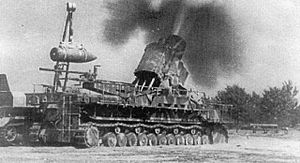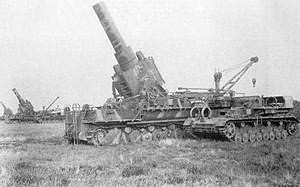Karl-Gerät
| Karl-Gerät 040 | |
|---|---|

60 cm Karl-Gerät "Ziu" firing in Warsaw, August 1944.
|
|
| Type | Self-propelled siege mortar |
| Place of origin | Nazi Germany |
| Service history | |
| In service | 1941–45 |
| Used by | Nazi Germany |
| Wars | World War II |
| Production history | |
| Designer | Rheinmetall |
| Designed | 1937–40 |
| Manufacturer | Rheinmetall |
| Produced | 1940–42 |
| Number built | 7 |
| Variants | Gerät 041 |
| Specifications | |
| Weight | 124 t (137 short tons; 122 long tons) (firing) |
| Length | 11.15 m (36 ft 7 in) |
| Barrel length | 4.2 m (13 ft 9 in) L/7 |
| Width | 3.16 m (10 ft 4 in) |
| Height | 4.38 m (14 ft 4 in) (firing) |
| Crew | 21 (Gun Commander, Driver, Assistant Driver, 18 x Gunners) |
|
|
|
| Shell | separate loading, cased charges |
| Caliber | 60 cm (24 in) |
| Breech | horizontal sliding wedge |
| Recoil | hydro-pneumatic |
| Elevation | 55° to 70° |
| Traverse | 8° |
| Rate of fire | 1 round/10 min |
|
|
|
| Engine |
Daimler-Benz MB 503 A gasoline or Daimler-Benz MB 507 C diesel 580 hp (590 PS) |
| Power/weight | 4.8 hp/ton |
| Suspension | torsion-bar |
| Fuel capacity | 1,200 l (260 imp gal; 320 US gal) |
|
Operational
range |
42 km (26 mi) (gasoline engine) 60 kilometres (37 mi) (diesel engine) |
| Speed | 6 to 10 km/h (3.7 to 6.2 mph) |
| Karl-Gerät 041 | |
|---|---|

A section of three 54 cm Karl-Geräte in the field. The Munitionsschlepper is shown on the right.
|
|
| Specifications | |
| Weight | 126.35 t (139.28 short tons; 124.35 long tons) (firing) |
| Length | 11.37 m (37 ft 4 in) |
| Barrel length | 6.24 m (20 ft 6 in) L/11.55 |
| Width | 3.16 m (10 ft 4 in) |
| Height | 4.38 m (14 ft 4 in) (firing) |
|
|
|
| Caliber | 54 cm (21 in) |
"Karl-Gerät" (040/041) (German literally "Karl-device"), also known as Mörser Karl, was a World War II German self-propelled siege mortar (Mörser) designed and built by Rheinmetall. Its heaviest munition was a 60 cm (24 in) diameter, 2,170 kg (4,780 lb) shell, and the range for its lightest shell of 1,250 kg (2,760 lb) was just over 10 km (6.2 mi). Each gun had to be accompanied by a crane, a heavy transport trailer, and several modified tanks to carry shells.
Seven guns were built, six of which saw combat between 1941 and 1945. It was used in attacking the Soviet fortresses of Brest-Litovsk and Sevastopol, bombarded Polish resistance fighters in Warsaw, participated in the Battle of the Bulge, and was used to try to destroy the Ludendorff Bridge during the Battle of Remagen. One Karl-Gerät has survived and the remainder were scrapped after the war.
In March 1936 Rheinmetall made a proposal for a super-heavy howitzer to attack the Maginot Line. Their initial concept was for a weapon that would be transported by several tracked vehicles and assembled on site, but the lengthy preparation time drove them to change it to a self-propelled weapon in January 1937. Extensive driving trials took place in 1938 and 1939 using the first Neubaufahrzeug tank prototype and a scale model to investigate the extremely high ground pressure and steering of such an enormous vehicle. Firing trials took place in June 1939. The full-scale driving trials were held at Unterlüss in May 1940. General Karl Becker of the Artillery was involved in the development, from whom the huge weapon gained its nickname.
...
Wikipedia
